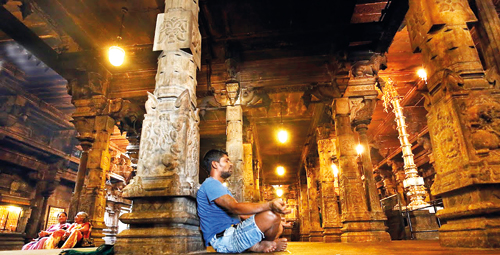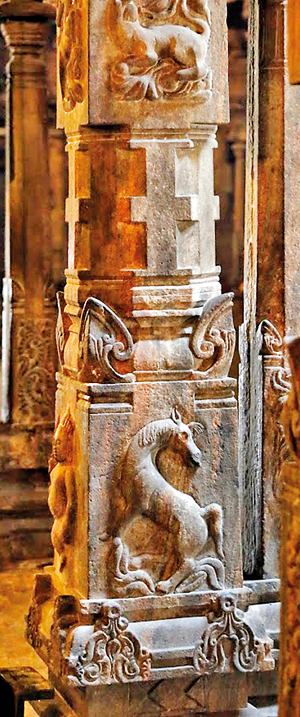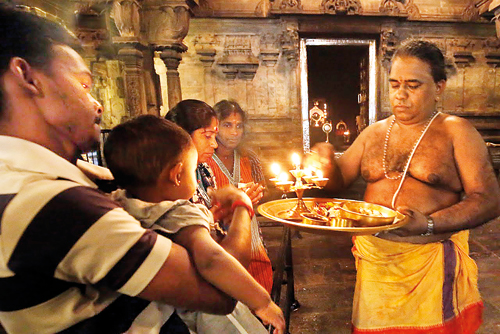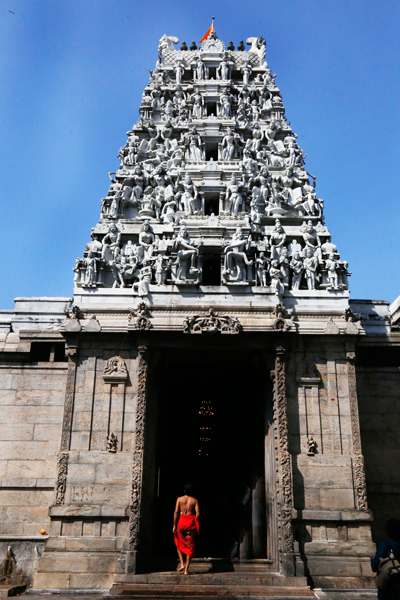A work of art, in all its granite glory

Seated cross-legged, eyes closed in veneration
The gentle scent of incense pervades the air and the calming chant of Om floats forth interspersed by the ringing of bells with the flickering flames of numerous oil lamps beckoning people into the dim-recesses within………therein an ancient world of rites and rituals opens up, spreading an aura of serenity and peace.
It is the Sri Ponnambalavaneswarar Devasthana simply known as the Gal Kovila/Palliya (Stone Temple), an awesome work of art which exudes an austere beauty.
A stone’s throw from the busy hub that is the Kochchikade junction, we access the kovil premises
through the western gate, pass a kolam drawn on the paved floor, step over split coconuts which have been dashed on the ground by devotees and flowers strewn by others to enter the sanctuary.

Intricately sculpted granite columns
All of granite it is, an initial small kovil being replaced by this low-slung structure, held up by thick granite columns decorated with intricate sculpture and a granite floor.
The columns we walk in through — having discarded our footwear and washing our feet — are sculpted with figures of Lord Natrajah (a form of Lord Siva), the dancing god, maidens in flowing garb and leaf and flower motifs, while dwara-palaka (door-guards) stand sentinel on the kovil’s roof edge.
We get its history from the main Trustee D.M. Swaminathan. There was a need for a large Sivan kovil and back in the 1850s, a group headed by Arunachalam Ponnambalam Mudliyar bought this five-acre block of land when Sea Street and New Chetty Street were like Cinnamon Gardens.
This followed a dream Ponnambalam saw — a pomegranate fruit in which was the Sivalingam.
The others who banded together were Ilankodar Mudliyar, Nanithambi Mudliyar, Sinnathamby Murugesar Mudliyar and some Chetties. Ponnambalam Mudliyar was appointed the Trustee.
“The first consecration of the temple was in 1857,” says Mr. Swaminathan, explaining that the sacred duty of the Trustee was next passed on to one of three sons of Ponnambalam Mudliyar — P. Coomaraswamy in 1887. His other sons were P. Ramanathan and P. Arunachalam strongly linked to the independence struggle of then Ceylon.
It was when Sir Ponnambalam Ramanathan became the Trustee that the temple was built with granite blocks all from Sri Lanka, with Indian architects and sculptors being invited to create this beauty.
Now too the kovil is being managed by a private trust consisting of the descendants of Ponnambalam Mudliyar and Mr. Swaminathan is the main Trustee maintaining and managing the temple in accordance with the values, rituals and rites of Hindus.
He has initiated many renovations and been instrumental in opening up the eastern entrance which had been a vital need. While the huge bell with chimes he had got from London, England, Mr. Swaminathan’s own dream is to right the “shortfall” in the form of the gopuram that adorns the entrance to the kovil. “I hope to build it in granite so that the whole structure will be of granite,” he says, pointing out that it is the only thing not made of granite.
Within the kovil, men, women and children are in deep prayer, with many a young mother hugging her baby close, eyes closed in veneration. Some are seated cross-legged before their pooja-trays either seeking favours from Lord Siva and the pantheon of Hindu gods or in thanksgiving for the fulfilment of vows.

Sacred rituals of worship with the Sivalingam at the rear
They have followed basic rituals to the letter – arriving at the temple after a cleansing bath and only a vegetarian meal. Before entering the sanctuary, they wash their feet and offer the trays bearing flowers and garlands, fruit including banana, coconuts, betel leaves, joss-sticks and camphor.
As one enters the sanctum, the shrine-centre or mulasthanaya bears the Sivalingam (this Sivalingam is known as Swarnasabeshwara) and an area to the right is dedicated to Siva’s consort, Parvathi (Sivahamasoundari). The Sivalingam is beyond the thick golden-hued kodisthambam (flagstaff).
Every god and goddess has his/her place along the rectangular walls of the kovil and also their vahana (vehicles), of course, with pride of place for the bull of Lord Siva. Named nandi, the bull rests adjacent to the flagstaff.

Sri Ponnambalavaneswarar Devasthana: A stone’s throw from the bustling Kochchikade junction. Pix by M.A. Pushpa Kumara
Pomp and pageantry surround the 10-day Mahauthsava (flag-hoisting ceremony) in March. The flag is hoisted on the first day, while on the ninth is the Chariot (Ther) Festival in all its grandeur, with Lord Natrajah being taken around the kovil grounds, while a smaller chariot with Parvathi follows. The tenth day witnesses the water-cutting ceremony on Panguni Uttaram.
Numerous festivals throughout the year attract large crowds. Next Tuesday is Thai Pongal, while the other important festivals include Aadi Pooram in July, a festival in honour of Parvathi; Navarathri in September-October to honour the Thri-devis (three goddesses) of Durga who symbolizes valour, Maha Lakshmi wealth and Saraswathi knowledge; Skandashashti in October-November which commemorates Soora Samhara, the battle in which good triumphs over evil, waged by Lord Muruga or Kataragama against the demon; and the 10-day Thiruvathirai festival in December when hymns are sung in praise of Lord Siva early morn.
Having walked around the Gal Kovil for nearly two hours, we leave at peace with the world, with holy ash smeared on our hairline, a large magenta pottu on our foreheads and a few pichcha (jasmine) buds and flowers clasped in our palms straight from the pooja-tray brought out from the sanctuary of the Sivalingam by a kurrukkal chanting prayers in Sanskrit.


